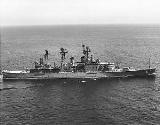
Providence class cruiser
Encyclopedia
Originally built as light cruiser
Light cruiser
A light cruiser is a type of small- or medium-sized warship. The term is a shortening of the phrase "light armored cruiser", describing a small ship that carried armor in the same way as an armored cruiser: a protective belt and deck...
s (CL) in the United States Navy
United States Navy
The United States Navy is the naval warfare service branch of the United States Armed Forces and one of the seven uniformed services of the United States. The U.S. Navy is the largest in the world; its battle fleet tonnage is greater than that of the next 13 largest navies combined. The U.S...
during World War II
World War II
World War II, or the Second World War , was a global conflict lasting from 1939 to 1945, involving most of the world's nations—including all of the great powers—eventually forming two opposing military alliances: the Allies and the Axis...
, in 1957 three ships were re-designated as Providence-class guided missile light cruisers (CLG) and fitted with the Terrier
RIM-2 Terrier
The Convair RIM-2 Terrier was a two-stage medium-range naval surface-to-air missile , and was among the earliest surface-to-air missiles to equip United States Navy ships. Originally, the Terrier had a launch thrust of 23 kN , and weight of 1392 kg...
surface-to-air missile
Surface-to-air missile
A surface-to-air missile or ground-to-air missile is a missile designed to be launched from the ground to destroy aircraft or other missiles...
system. During the two year refit, the aft superstructure was completely replaced and all aft guns were removed to make room for the twin-arm Terrier launcher and a 120 missile storage magazine. Three large masts were also installed in order to hold a variety of radar
Radar
Radar is an object-detection system which uses radio waves to determine the range, altitude, direction, or speed of objects. It can be used to detect aircraft, ships, spacecraft, guided missiles, motor vehicles, weather formations, and terrain. The radar dish or antenna transmits pulses of radio...
s, missile guidance
Missile guidance
Missile guidance refers to a variety of methods of guiding a missile or a guided bomb to its intended target. The missile's target accuracy is a critical factor for its effectiveness...
, and communications
Telecommunication
Telecommunication is the transmission of information over significant distances to communicate. In earlier times, telecommunications involved the use of visual signals, such as beacons, smoke signals, semaphore telegraphs, signal flags, and optical heliographs, or audio messages via coded...
systems. Providence and Springfield were simultaneously converted into fleet flagship
Flagship
A flagship is a vessel used by the commanding officer of a group of naval ships, reflecting the custom of its commander, characteristically a flag officer, flying a distinguishing flag...
s, which involved removing two forward dual 5 inches (127 mm) and one triple 6 inches (152 mm) turrets, and replacing them with a massively rebuilt and expanded forward superstructure. Topeka, in the non-flagship configuration, retained the Cleveland-class's standard forward weapons: three dual 5 inches (127 mm) and two triple 6 inches (152 mm) turrets.
A similar pattern was followed in converting three other ships (Galveston, Little Rock, and Oklahoma City) to operate the Talos
RIM-8 Talos
The Bendix RIM-8 Talos was a long-range naval surface-to-air missile, and was among the earliest surface-to-air missiles to equip United States Navy ships. The Talos used radar beam riding for guidance to the vicinity of its target, and semiactive radar homing for terminal guidance...
surface-to-air missile
Surface-to-air missile
A surface-to-air missile or ground-to-air missile is a missile designed to be launched from the ground to destroy aircraft or other missiles...
system, creating the . Little Rock and Oklahoma City were outfitted as fleet flagships, but Galveston was not.
Like the Galveston class cruisers, the Providence class ships suffered from serious stability problems caused by the topweight of the missile system, requiring the use of ballast to improve stability. The cruisers also suffered from hogging of the hull.
All three ships were decommissioned to the reserve fleet between 1969 and 1974. In the 1975 cruiser realignment
United States Navy 1975 ship reclassification
The United States Navy reclassified many of its surface vessels in 1975, changing terminology and hull classification symbols for cruisers, frigates, and ocean escorts.- Classification prior to 1975 :...
, Providence and Springfield were reclassified as guided missile cruisers (CG). The ships were stricken from the Naval Vessel Register
Naval Vessel Register
The Naval Vessel Register is the official inventory of ships and service craft in custody of or titled by the United States Navy. It contains information on ships and service craft that make up the official inventory of the Navy from the time a vessel is authorized through its life cycle and...
between 1974 and 1980, and eventually sold for scrap.
Ships in class
| Keel laid | Launched | Commissioned | Decommissioned | |
| Providence (CLG-6) USS Providence (CLG-6) USS Providence , a Cleveland-class light cruiser was the fourth ship of the United States Navy to be named after the city of Providence, Rhode Island.-Construction and commissioning:... |
July 1943 | December 1944 | September 1959 | August 1973 |
| Springfield (CLG-7) USS Springfield (CL-66) USS Springfield was one of 27 Cleveland-class light cruisers built for the United States Navy during World War II. She was the third US Navy ship to be named after Springfield, Illinois. Commissioned in 1944, she served briefly in the Atlantic before transferring to the Pacific... |
February 1943 | March 1944 | July 1960 | May 1974 |
| Topeka (CLG-8) USS Topeka (CL-67) USS Topeka , a Cleveland-class light cruiser was the second ship of the United States Navy to be named after the city of Topeka, Kansas.-Construction and Commissioning:... |
April. 1943 | August 1944 | March 1959 | June 1969 |

